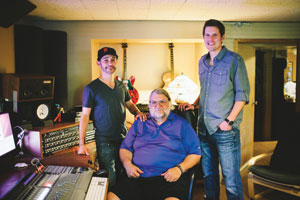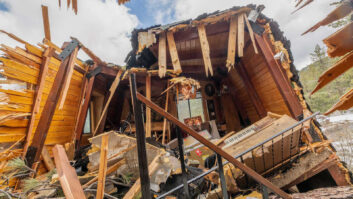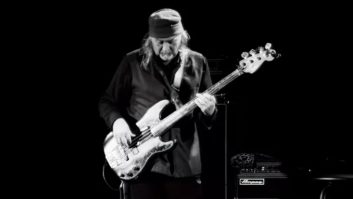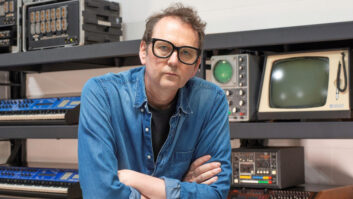
Nate Hawtin, Bryan Bell and Greg Nestler at Falcon West Studios in Portland, Ore.
If you’ve never heard of Nestler & Hawtin, a pair of soulful young singer-songwriters from Oregon, don’t fret. They’ve barely ventured outside of their native Pacific Northwest during their time together. But the story of how their excellent first album, Duality, came together is a fascinating and instructive saga that says much about independent recording in this era of small budgets, but expanded opportunities to work in inexpensive and creative ways.
Okay, so not every act is going to be able to snag the likes of guitarist Ray Parker Jr., bassist Freddie Washington (Herbie Hancock, Steely Dan), keyboardist David K. Mathews (Santana), percussionist Karl Perazzo (Santana), guitarist Todd Carver (Tony Williams) and backup singer extraordinaire Vicki Randle, among others, nor hire mixer Niko Bolas and mastering ace Richard Dodd. Those folks ended up working on Duality because the album’s versatile producer/mastermind, Bryan Bell, has built an incredible network of connections in more than 40 years in the music business. Bell’s stamp is all over the album, and it is his ingenuity and studio know-how that allowed the album to be made the way it was without breaking the bank.
Bell has enjoyed an amazingly rich career in music. A fine guitarist and keyboardist, with a deep understanding of audio from a young age, he got his first big break when he met the great fusion guitarist John McLaughlin and was hired to mix front-of-house for the third version of McLaughlin’s Mahavishnu Orchestra in the mid-’70s. From there, Bell went to work for Herbie Hancock, for whom he also mixed FOH and worked as a keyboard tech and helped develop/invent systems and methodologies to better integrate Hancock’s massive arsenal of synths and other keys—including a remarkable pre-MIDI setup—both onstage and in the studio.
His years with Hancock included the latter-day Headhunters and the all-star VSOP group, among many projects. He did mixing and tech for Santana for a period, then moved on to a stint working on computers (and playing keys on a few songs) with Neil Young and Crazy Horse. For the past 27 years, he has volunteered for the Bridge School, including the Technology Advisory Board and the Board of Directors.
He helped design and equip the studio for The Tonight Show with Jay Leno (through his connection to bandleader Branford Marsalis), and he has also spent decades developing his umbrella business, Synth-Bank, which includes everything from music production to audio engineering to consulting on technology for large and small companies—many not even involved with music. Bell’s Synth-Bank pioneered the sales of sounds and music online in the 1980s. These days he does much of his work out of his “very ambitious project studio” in Gig Harbor, Wash. (near Seattle), although the Duality project would take him to many locales on the West Coast.
One could say that Bell’s involvement with Greg Nestler (guitar and vocals) and Nate Hawtin (guitar, cello, keyboards and vocals) was years in the making. “Greg was a family friend,” Bell relates. “His grandmother is friends with my mother. So his mother used to come to my parents’ Christmas parties [in Portland, where Bell partly grew up] and bring her kid in tow, when he was 11, 12, 13 years old. And he’d always hear the great exploits of Bryan Bell’s touring life. It was like, ‘Where’s Bryan this year?’ So this kid heard a lot about me growing up, and at some point he decided he wanted to write music. He started sending me demos at the age of 14. I’d say, ‘This sucks, but keep going.’ Fifteen: ‘This sucks, keep going.’ Same at 16. And by the time he was about 23, he sent me a demo that had 15 great songs, so I said, ‘Okay, now let’s make a record,’” he laughs. By that time, Nestler and Hawtin were out of college and playing as a duo, their voices blending beautifully, and crafting original tunes that moved from folkish numbers to R&B-flavored tunes and even some out-and-out rockers.

Hawtin and Nestler singing background vocals at Falcon West.
Bell immediately saw the potential to make an album that extended their sound from their acoustic base to something much deeper and more developed, with both jazz and rock shadings, or as Bell put it, “I wanted it to have some Steely Dan feel, or Paul Simon back when he used Steve Gadd and Richard Tee.” In short, breezy and intelligent with solid grooves.
The challenges started immediately. “The problem was,” Bell says, “we didn’t have a budget, I was working a day job, and they lived in Oregon, so we had this distance problem—it was a five-hour drive to Eugene. So what we did is use WebEx software, which is like Skype—you can do video conferencing and screen sharing, and you can also do remote control, which means I can drive the other guy’s computer. The one thing you can’t do in WebEx is sync the audio properly, so the way we got around that later is we set up weekly video conferences, and we used email and Dropbox to move files. So, they’d start writing in GarageBand and they’d record a piece of the song—a verse and a chorus, a bridge, something—and then we’d have this conference and we could email ideas back and forth.
“I was able to say, ‘Try a counter-melody here,’ or ‘Let’s make the chorus twice as long,’ or ‘Let’s move the bridge to the front,’ and because of WebEx, I could actually edit on their computer—I could reach into their screen and cut their GarageBand files. Or I might write a melody and say, ‘How about this for the cello part?’ and they’d record it in GarageBand and we’d go over it the next week.’ It really was almost like we were sitting there together.”
Once the songs were ship-shape lyrically and musically, Nestler and Hawtin went up to Bell’s studio “and started working in Digital Performer, which is my favorite tool for both recording and editing. We rehearsed for a few days, we got the tempos perfect, we got the scratch guitar and scratch vocal at the right tempo and the right feel for all the tracks. We were recording in high resolution—96k—using groovy, expensive microphones and expensive preamps, so we’re getting these first four to six tracks pristine in my home studio.
“Then we bought Digital Performer for their laptop, and from that point forward, we could use Dropbox. I’d say, ‘I’ve written this part.’ Or. ‘Here’s a new keyboard part,’ and we would sync them using Dropbox. If they wrote a new cello part that was good, I could bring it into their master and into my master in sync.”
During this initial recording stage the threesome concentrated on getting keeper lead vocals, counter and background vocals, and rhythm guitar “all cut to a click,” Bell says. “I have an MPC 60, so I banged in sketches of drum parts, too. So we did the final vocals first. Most records you do that last. But we wanted to build around them and really capture the meaning of the song.” Bell used a Sony 800-G for most of the vocals “and on one or two we used vintage Neumanns.

Bryan Bell at his trusty laptop.
“After that, we started the overdubbing process,” he continues. “My studio partner in Portland is called Falcon Studios, and Dennis Carter, the owner, is one of my favorite drummers. He also has Digital Performer and 40 channels of Apogee, so we went there and cut drums to the click; just a couple of days—10 songs in two or three days. And that was really the first thing we’d paid for on the whole project, because everything else had been in my studio or GarageBand or using cheap Dropbox or WebEx subscriptions I had.
“Then I went on the great overdubbing trek. I had a laptop with Digital Performer and a portable interface—at the time I was using a MOTU Traveler—and I started calling my musician friends.” He caught up with bassist Freddie Washington when he was on tour in Roseburg, Oregon, with Michael McDonald, Boz Scaggs and Donald Fagen in the Dukes of September: “I brought my laptop and UAD Satellite with all my plug-ins to the hotel the day before the show, and I set up a 2.1 monitor system and two DIs and a bass rig, and we did 10 songs in five hours. It was fantastic.” And so it went. He captured B-3 and piano parts over two days at the SF Bay Area home of Santana keyboardist Dave Matthews, did Jay Koder’s and Tod Carver’s guitar parts up in Oregon, and tracked down Ray Parker Jr. in L.A., while the esteemed Niko Bolas—a friend of Bell’s since their days together with Neil Young in the ’80s— mixed in Pro Tools in his room at Capitol Studios in Hollywood, before turning it over to mastering engineer Richard Dodd in Nashville.
“This album was literally recorded one track at a time over about six months,” Bell says, with a couple of songs requiring around 80 tracks (and an external Thunderbolt solid-state drive, once his internal hard disk was almost maxed-out). Amazingly, though, it sounds like it was performed by a real band playing together, with Nestler and Hawtin soaring above the fray with their impeccable vocals and driving guitars (and cello). It was, unquestionably, quite a feat for all involved to pull it off.
Marketing a genre-crossing album such as this is its own challenge, Bell admits, but he’s confident that the quality of the songwriting and performances will ultimately get it noticed, perhaps building from a college or Internet radio start.
“One of the messages I want to get out,” he says, “is that all these inexpensive tools are here now and you can take advantage of the same computer you use for your day job to make an album that sounds as good as some of the best stuff you hear on the radio.” Still, he notes with a chuckle, “I think for the next album we might do a simple acoustic record with just vocals, guitar and cello.”
Online Extras
More from Bryan Bell on how he got into music and some tales from earlier in his career:
On his family background and getting into music: “I split my time growing up between New Orleans and New Mexico. My father was a classical conductor, composer and educator, and my mother had been a cellist in the symphony he was conducting; that’s where they met. So I was born in New Orleans, which is where my mother is from. My dad was a New Yorker, and he got a job in New Mexico as the artistic director for their arts center, so he ran their symphony and light opera. He did choral music on the side; that was his specialty, and he had been a choral arranger in New York.
“We had a full 2-track studio at the house. At one point my father had been the choral conductor at Radio City Music Hall, and he had gotten some surplus equipment from them, so he had a beautiful tube setup, and I started messing around with that when I was pretty young. I made my first record when I was 11.
“I played piano as a kid and was interested in choral-type things because of my dad’s influence, but once I reached puberty, I realized playing guitar was better for [attracting] girls than keyboards, so I started playing a little guitar. By the time I was in college [at Portland State; his parents divorced and his mother re-married and moved to Oregon], I fancied myself a great guitarist and a great keyboardist and I had an ego that didn’t fit through most doorways. [Laughs] Then I found a little humility through John McLaughlin. I started studying his music and became a friend of his through the Sri Chinmoy spiritual organization. I immediately realized that’s a great guitar player, not me! I was very heavily influenced by him as a guitar player, and I was really fortunate to get the opportunity to work with him mixing house.”
On working with Herbie Hancock: “Then my second job was with Herbie Hancock, so I thought, ‘Being a great keyboard player is off the table, too.’ [Laughs] ‘That’s OK, I’ll be a composer.’ Then I met Wayne Shorter!
“For Herbie, I was front-of-house mixer, the sound company contractor—I was sort of a profit-sharing partner in the touring P.A.—and I was Herbie’s keyboard tech. The first tour I did with Herbie was the Headhunters with Mike Clarke, Bill Summers, Paul Jackson and Bennie Maupin. And that’s how Herbie and I met. Mahavishnu opened for the Headhunters and Herbie heard me mix Mahavishnu and asked me to speak with him about working for him.
“Herbie always carried a lot of stuff. I think that first tour we had a Fender Rhodes, an Oberheim 8-voice, a Clavinet, two Arp Odysseys and an Arp String Ensemble. One Odyssey was programmed for bass and one was programmed for leads, solos. The funny thing about it is I wasn’t really a keyboard tech when I went to work for Herbie, so I had to get up to speed pretty quickly. But then we ended up building a substantial system for Herbie where I kind of interfaced his entire studio together and also took the whole rig out on the road. I created a master clock, notation libraries, digital patchbays to switch the keyboards, tuning and triggering interfaces for every brand of keyboard we had, and even direct memory addressing, so we could take the sounds of the keyboards and put them in a master computer. We did about 14 different inventions.
“I ended up working for Herbie for about eight years—he was my biggest client during those years; I would sneak off and do other things, like I produced a Hawaiian band called Kalapana. I got to work on a bunch of his records, too. I would say there were at least 100 sessions where I would go with Herbie and do his band gear, and then if they needed me to get his sounds, I would do just his sound to make sure it was always right. On the live jazz stuff—like with VSOP, that great band Herbie had with Ron Carter, Tony Williams, Wayne Shorter and Freddie Hubbard— I’d mike the stage, Fred Catero ran the truck, Herbie ran the band and David Rubinson produced.
“Working with Herbie was really cool because we got the first of everything—I got to work on the first live digital recording live in Japan [with VSOP]—it was the first time Sony used their big digital recorder, right out of the lab.”
On working with Santana: “Carlos and I had met socially [through their mutual association with Sri Chimoy] and I was also friends with an engineer whose name was Leo Hoarty, whose spiritual name was Swapan—he had done work for John McLaughlin when I worked with him. So I’d go to San Francisco to visit the Sri Chinmoy Center and I’d end up going to Carlos’ house with Swapan and work on his console, and then, when I went to work with McLaughlin, Leo was actually the electronics tech.
“Then, at some point, while I was working with Herbie, I started consulting for Carlos, sort of on my days off. I had a good relationship with his manager, Ray Etzler. So I did a little bit of consulting on the ‘Shango’ tour—I helped with sound. Then I’d go back and do a record and a tour with Herbie and there would be two weeks off, or something, and I’d go out with Carlos and consult, because at the time, Carlos owned his own sound system and it was sometimes a little problematic. Ultimately, when I left Herbie, I had kind of standing offer to work with Carlos. So I went full-time managing the sound company and mixing the house and sort of being the electronics tech, as well. They already had a great guitar roadie and a great keyboards roadie, so at least I didn’t have to do that.”
On working with Neil Young: “I went from Santana to Neil Young. I did computers for him and Crazy Horse. We had 40 channels of MIDI and two Synclaviers in Crazy Horse, so it was quite technical. It was also the first time I didn’t have to mix house, too. You have to understand that with Herbie, I drove the truck, I was stage manager, I was keyboard tech, I mixed the house, I worked on the records and managed his research and development. We were working constantly and it was always more than two jobs; I was doing three jobs sometimes.
“Neil is one of these guys who wants you all-in—you work with Neil and you negotiate with him once a year and he says, ‘How much do you want to do whatever I want you to do for 12 months? And you give him a number and then you can’t talk about money for 12 months. Then, if you think you gave him the wrong number, 12 months later you give him a different number. So it’s not like, ‘I’m your keyboard tech I can’t work on the P.A. You’d do whatever he wanted. Neil actually had roadies playing in the band, too; I got to play keyboards on a few songs, which was really fun.
“Neil and I did a bunch of writing off the road, where he composed and I ran the computers. One morning he called up and left a message on my answering machine and sang a song as he was driving off the ranch. He said, ‘I tried this song with the Harvesters, I tried it with Crazy Horse, I tried it with this other band, and we haven’t been able to get it. I tried it solo and it still doesn’t feel right. Let’s try it with the computers.’ So he sings the song to me—and you can hear him working the shift in the truck in the background—and it sounds great. And he says ‘How does today sound?’ Well, I lived in Portland at the time, so I wake up at 8:30 and listen to the answering machine, and I was like ‘Oh, crap he means today, today.’ So I grabbed the answering machine tape, flew to San Francisco, rented a car, drove to the ranch [south of SF], put the cassette up and we loaded it into the computer. Then I’d put in a kick and a snare and bass part [from the computer] and he’d say, ‘I don’t like the snare sound,’ and we’d work on his idea of a snare sound, so it was often this exercise in throwing away my parts and putting in his ideas, but at least it gave us a place to start. I loved it, because sometimes he liked the things I did and sometimes he didn’t, but it was real interactive and so I really got to watch him work.
“So we did the song [“This Old House”] and we got great track in the Synclavier—we had a bunch of MIDI gear and the Synclavier and a Mac with a master sequencer. We put this track together and it came time to do vocals and the vocals in the studio didn’t sound as good as the ones on the cassette from the truck. ‘Damn, the cassette feels better than the record.’ Neil liked to record vocals around the full moon—the day before, the day of, and the day after; we’d call it ‘losing the moon’ when we’d start to run out of time—so what we finally did is we put PZM microphones on the ceiling of his truck, put the truck on the steps of the studio and waited till midnight, when the light of the moon came shining through the truck window, and recorded the lead vocal in the truck. It sounded fantastic and it actually ended up on a CSNY record [American Dream, 1988].”
“Neil’s creative environment was always really strong. You’d ask, ‘What’s the sound you want for this snare?’ and he’d say, ‘A combination of a Winchester [rifle] and a couple of 2-by-4s being slapped together.’ And you were literally tasked with doing that. If you had Winchester sound in the Synclavier, great; if you didn’t you borrowed a rifle.”
On his post Neil evolution: “After that, MIDI became really popular. Dave Smith and Roger Linn were two of the big players in MIDI, and I guess I was kind of peripheral player. I had done this big custom system with Herbie. Basically, all of the architecture of MIDI we had done earlier with Herbie’s keyboard system years earlier. We had the ability to assign control of the voices, you had program change, we had sound libraries and we had online storage and retrieval. We had a higher clock rate than MIDI; we had our own master clock. Anyway, when MIDI hit there were all these bands that suddenly wanted MIDI and they’d call Dave Smith and he’d say, ‘Sorry I’m running my keyboard company,’ and they’d call Roger Linn and he’d say, ‘Sorry I’m doing my drums,’ and then they’d call me and I’d say, ‘What’s your budget?’ [Laughs] So I had this miraculous situation where I had to say, ‘Should I do Neil Young or Prince? Sting or Santana? Should I do Michael Jackson or The Tonight Show? I was overbooked like crazy. I did INXS’s Suicide Blonde project and designed their world tour [electronics] and then it became just designing tours and designing project studios.”
“I left touring to do The Tonight Show for Branford Marsalis. I met Branford on his brother Wynton’s album in Tokyo, and later Branford toured with Herbie for a summer [in 1981], and I helped him design his rig for the Sting tours. When Branford got the job as the musical director for The Tonight Show, there had to be a technical conversion from Johnny Carson to Jay Leno. Carson’s band was like old-school Vegas guys. They had nothing technical; their console was 25 years old; quite funky. So we built a totally new Tonight Show band setup and also built the setup for the visiting band, the audio for the theater, and then we did a digital studio for Branford’s office, and a sister digital studio for Branford’s home, so he could just bring optical disks back and forth. I did the design and the negotiations for all the production assistance agreements with the vendors. I stayed there for two years and then, actually, Poncho [Frank Sampedro] from Crazy Horse took over for me and he stayed there until the end, then he went back to Neil.”
A last thought: “I have been very fortunate to work with so many talented artists over the years. I am eternally grateful to each and every one of them for allowing me to share in their creative process and be part of their world.”







